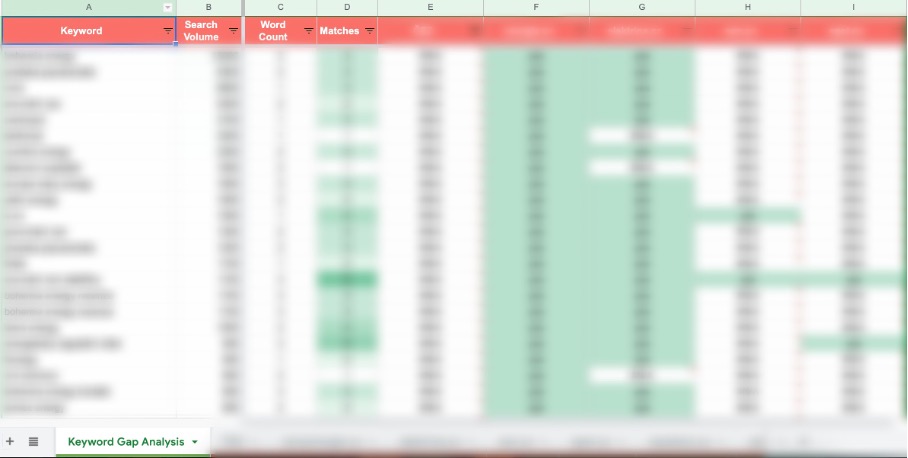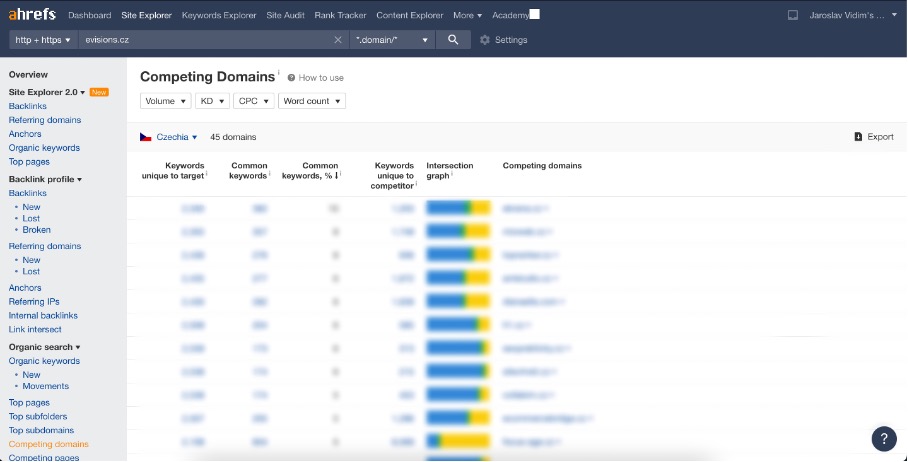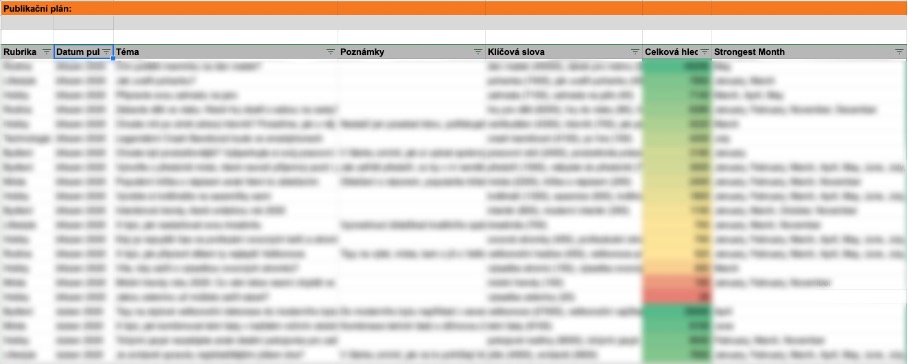How to Create a Content Plan in 3 Steps
09. 03. 2022 AutorDo you want a successful blog? Then you definitely need a content plan. In this article, we will show you how to create your own content plan in three steps, and at the end share with you a free content plan template.
What is a content plan?
A content plan is a document with which you approach the publication or revision of your blog articles in a data-driven way. This document includes the articles to be published, the keywords, the best month to publish, and the potential discoverability of each topic.
It is an effective way to reach out to your audience and help them engage with the content you publish in an organized manner. By breaking down each piece of content by topic/theme/prompt/etc., it will be easier for you to create something more cohesive when it comes time for publishing!
It is especially important if your blog is in the starting blocks of being noticed by search engines and users. For already established blogs, on the other hand, the content plan often includes articles for revision or republication.
What makes a good content plan?
A good content plan is one that is well-thought-out and takes into account the company’s goals, target audience, resources, and time constraints. It should also be tailored to the specific mediums that will be used to disseminate the content.
Making a good content plan can be difficult, especially if you’re not sure what to focus on. Here are a few tips to help you determine if a content plan is right for your business:
- Is the content relevant to your company’s target audience?
- Are you achieving your business goals with your content strategy? If not, what are you able to improve on?
- Does the plan include a schedule for content creation and distribution?
What do you need for a content plan
A content plan without a sound analysis of keywords and content gaps won’t work. In addition, you also need to keep an eye on your competition, more specifically: your SEO and content competitors. When you analyze your competitors’ websites, you look at what they write about, how they write, what form they’ve chosen for their content, and how high their word coverage is in search results.
To analyze all this data, you absolutely need tools like Google Analytics, Google Search Console, or Ahrefs. Without them, you can’t create a content plan that works.
You need to have a clear idea of your target audience and what you want to achieve with your content. You’ll also need to have a good understanding of your company’s strengths and weaknesses when it comes to content marketing. Having a content strategy that aligns with your overall business goals is essential for success.
Here are three simple steps that will help get you started.
1. Keyword analysis
The purpose of keyword analysis is to give you a comprehensive overview of the keywords relevant to your blog. You can then use this to create a rough outline of the individual topics for your blog.
We have already published detailed instructions for keyword research in another article on our blog.
The result should be a list of keywords that are most searched for, relevant, and ideally least contested. However, don’t just focus on keywords with high search results, but also consider the so-called “long-tail keywords“, which are not searched on a large scale, but are much more specific and less contested. With these, you can increase the chance that your content will be noticed by search engines.
For example, with a term like “How do I optimize a website for search engines?” you have a better chance of appearing in the top positions in the search engines than with a more general term like “SEO optimization”. This has a high search volume but is also highly contested, so it is very difficult to appear in the search engines because the front places are already occupied by others.
Tip: When doing keyword analysis, you need to distinguish between phrases that are served on large websites – such as the keyword “travel insurance” – and terms that are more suitable for a blog. In this case, it could be phrases like “how to get travel insurance”, “how to choose travel insurance”, etc.
 Here’s what a keyword analysis can look like. In addition to the column layout shown above, it also includes categorization and segmentation to help you keep track of the considerable volume.
Here’s what a keyword analysis can look like. In addition to the column layout shown above, it also includes categorization and segmentation to help you keep track of the considerable volume.
2. Content gap analysis
Content gap analysis helps you see how your content compares to that of your competitors. It will show you all the keywords that your competitors are ranking for but you are not. This allows you to cover different keyword phrases and individual keywords that may not have even come up in your keyword analysis.
It takes a lot of time to do a really good content gap analysis. Since you should include at least five competitors in your analysis, you’ll end up with a fairly large data set. Cleaning this up and then selecting keywords will take a few hours. For larger websites or industries with a broad spectrum, such as travel, insurance or finance, the entire process can easily take more than ten hours.

Content gap analysis in Ahrefs
For a smaller content plan with up to 50 topics, you can use the Ahrefs marketing tool, which helps you define your biggest content competitors and perform the content gap analysis mentioned above with just a few clicks. The result may not be as comprehensive as the in-depth analysis described above, but you’ll save time you’d otherwise spend sifting through tens of thousands of keywords.
TIP: When working with Ahrefs, always make sure that you have selected the correct country. You can then reduce the high volume of keywords by filtering out the competitors’ key brand terms and possibly selecting only those that have a search volume of e.g. more than 500 or only appear on positions 1-10 ( which corresponds to the first page of the search engine).
3. Competitor analysis
Mapping your competitors is one of the most important steps even before you create the content: you get an overview of the topics your competitors write about and you learn about your visibility in the organic search results (i.e. keyword coverage).
The first step in competitor analysis is to identify your competitors. Be careful, not always the direct competitor is also the content or SEO competitor. The aforementioned Ahrefs helps you identify your competitors within the content, through the Competing Domains tab.

Alternatively, you can use the Marketing Miner analysis tool. Here you need a keyword analysis, whose data set you insert into the keyword report. Then select the Prospecting Miner feature.
For your competitor analysis, also consider various industry blogs and magazines, as well as search results and suggestions from search engines like Google.
Once you have an overview of your competitors, research them in detail – what content they create, how often they publish articles, what categories and tags they use, and last but not least, what the articles themselves look like:
- Whether they are visually appealing and readable
- What their scope is
- How they are optimized
- What their tone of voice is
Then, compare the information you received with your website and look for ways to improve it, e.g. if it would be possible to add lifestyle topics to the blog, add categories for better navigation, improve the articles graphically, etc.
Creation of the content plan
After a detailed analysis of the segment and your content competitors, the actual creation of the content plan follows. It is important that you get an insight into the particular field and be clear about where you want to go. This is how you should proceed:
Research the keywords and competition
First, look at the data you gathered in the keyword analysis, content gap analysis, and competitor analysis. After that, you’ll have an idea of what content you can include in your plan, and you’ll be able to choose at least the basic topic areas.
Create a mind map and brainstorm your ideas
Brainstorming in a team is the perfect way to save time, because more heads know more, as we all know, and you can come up with much more together with other copywriters and content specialists. Plus, in a relaxed atmosphere, it’s easier to think outside the box and come up with interesting and new ideas.
If you’re working on the content plan alone, a mind map can also get you started. Draw the topic headings and assign a specific shape to each article. Then you can let your imagination run wild and write down whatever comes to mind. Revise the mind map again later in the creation process.
Unify the information into a content plan
After you have organized all your collected data and ideas, you should have the following information:
- Topic headings
- Specific article topics
- appropriate keywords for each topic
- Suggestions for relevant categories
- Suggestions for publication dates
Next, write down each topic in a so-called publishing plan and assign the keywords for which you want to optimize the article (ideally at least three, but it can be more).
Remember that you are still starting from the data you have collected (through keyword research, content gap analysis, etc.). So take the main keywords from these sources, but you can also look at the additional keyword suggestions in Marketing Miner and supplement the main keywords with secondary keywords that will help you specify the article.
Add a publication date, category, or content type to your content plan
Add columns to the plan that contain the following:
- Subject
- Keywords
- Suggested publication dates
- The category the topic falls into
- The discoverability of each topic
Optionally, you can add more columns if needed, for example:
- Content type
- Text area
- Text structure
- Annotations
- Inspiration, etc.

We have also prepared a simple Blog content Plan template for you to download.
How to choose the right publishing date for your article
Choose the main keyword from the keywords that fit the topic (usually the keyword with the highest search volume) and find out its monthly search volume – this is easy with the Marketing Miner tool and the Keyword Report. This way you’ll find out in which months the keyword is most searched for, and you can adjust the publishing date accordingly.
However, this will not always be sufficiently meaningful and realistic, so you also need to take into account the seasonality of the topic. For example, you won’t publish articles about Christmas in December, even if your main keyword is most searched for in that month.
TIP: When setting the publication date, remember that it takes time for crawlers to index the article and, in simple terms, take note of it. Therefore, it should be published a month (or more) in advance.
Reuse previously published articles
You can also include the revision of previously published articles in your plan. It’s especially advisable to edit articles with important information that changes or will change frequently. Look at your most searched articles in Google Analytics and consider whether you can still use them in some way. You may find that the previously listed information needs to be updated.
Conclusion
It takes time to create a really good content plan. In order for your blog posts to be high quality and bring you regular organic traffic, you need to choose topics based on data. There is no limit to your creativity, but it is not always enough for a well-functioning blog.
Always create your content plan based on the data you collect:
- Keyword analysis
- Content gap analysis
- Competitor analysis
It’s important that you have at least a basic understanding of your client’s industry. This is what the above mentioned analyses are for, they will help you not only to get an idea of the industry or segment, but also of the topics you can cover in your blog.
The resulting topic suggestions should be based on all the data and keywords you’ve collected. They will especially help you know what to write about. Keyword analysis and content gap analysis are used to select keywords for each topic, and you can find additional keywords in Marketing Miner, Ahrefs or other keyword search tools.
Thanks to the competitor analysis, you will know how your competitors are doing and what you can do better or differently, among other things. When looking at competitors’ content, pay attention to the type of articles, the visuals, and also the visibility of competitors in organic search.
Then create specific themes based on all the data you’ve collected. Always assign at least three keywords to them. Don’t be afraid of long-tail keywords – they are searched for less often, but are more specific and less contested, so you are more likely to appear in the first search positions with them. Finally, add categories, publishing dates, and other important details to your topics and keywords in your content plan.
A content plan is the foundation for a well-functioning and well-read blog. If you know what people are looking for, you can write articles that really interest them and that will drive organic traffic to your blog.










Komentáře